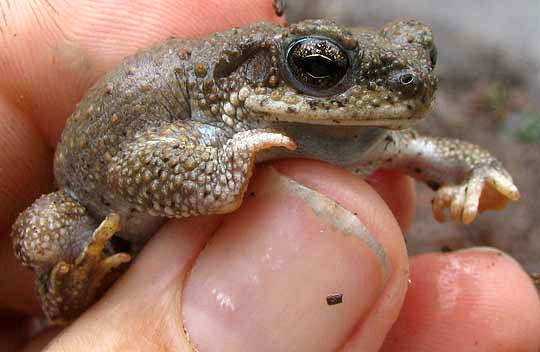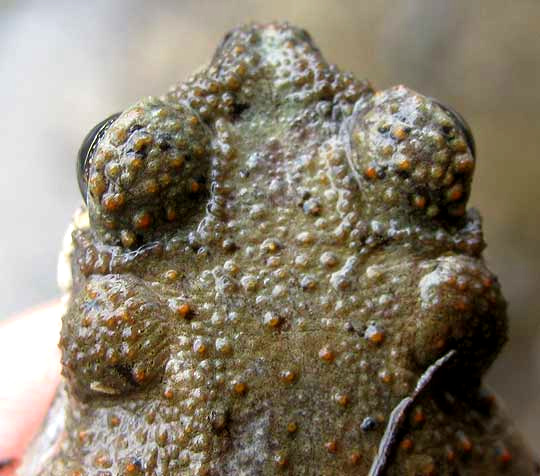Excerpts from Jim Conrad's
Naturalist Newsletter

from the June 23, 2013 Newsletter issued from the Frio Canyon Nature Education Center in the valley of the Dry Frio River in northern Uvalde County, southwestern Texas, on the southern border of the Edwards Plateau; elevation ~1750m (~5750 ft); N29.62°, W99.86°; USA
RED-SPOTTED TOAD
Our friend Dave had invited us to his sprawling, hilly ranch just south of here. As we were leaving it was getting dark so Dave turned on a porch light, which brought from his hiding place a warty little toad who stationed himself beneath the light where on previous nights he must have dined on bugs who'd crashed into the light and fallen to the porch floor. That's the toad above.
When you're photographing a toad you're planning to identify later from the pictures, you need to get a shot from above showing the "cranial crests." Cranial crests look like short, branching segments of slender wires inserted beneath the skin atop a toad's head just behind the eyes. The crests display different patterns from species to species. Since toad species tend to vary in terms of color and markings, sometimes noting the cranial crests is critical. If you want to know more about cranial crests, check out our American Toad page, where noting the crests was important, at http://www.backyardnature.net/n/a/am-toad.htm.
However, this toad on Dave's porch hopped away before I could get a picture from above, plus I'd already noticed that this toad, amazingly, didn't seem to have any cranial crests at all! This was so unusual that their absence in itself constituted an important field mark.
It turns out that Texas state government has a page on Frogs & Toads of Texas. By matching our toad with pictures of the 43 or so species listed for Texas, I settled on the Red-spotted Toad, BUFO PUNCTATUS. Red-spotted Toads are found from southwestern Kansas to southwestern Colorado and southeastern California south through arid northern Mexico. In Texas Red-spotted Toads occupy about the western two-thirds of the state.
Besides the near or complete absence of cranial crests, another good field mark for the Red-spotted Toad is the small size and almost round shape of the toad's parotoid glands -- the "poison glands" that look like beans beneath the skin just behind the eyes. Though I read that individual Red-spotted Toads tend to be whitish where there's outcropping limestone, but light tan to red in volcanic areas, the white upper lip and body undersurface seem to be more or less constant throughout the species. And, of course, the toad's warts tend to have reddish peaks, which accounts for the red-spotted name.
Red-spotted Toads occupy rocky areas and open grasslands of arid regions, typically remaining near a water source such as a spring, stream, or pond. At Dave's I didn't see such a water source, but maybe there was at least a leaky faucet someplace.
from the June 1, 2014 Newsletter issued from the Frio Canyon Nature Education Center in the valley of the Dry Frio River in northern Uvalde County, southwestern Texas, on the southern border of the Edwards Plateau; elevation ~1750m (~5750 ft); N29.62°, W99.86°; USA
CLOUDBURST BRINGS OUT TOADS
For months I've been speaking of our very severe drought. This Monday, on Memorial Day, we had a cloudburst unlike any I've seen since being here. For several hours nobody in the valley came or went because deep water rushed across all our "low-water crossings." Neighbor Phred says we got six inches (15cm), while Uvalde received eight.
The next day, toads were calling, and along the road I caught the one shown below:

That picture, with my thumb for scale, shows one good field mark for the species, which is that it's very small. Another striking feature is that when captured the toad closed his eyes and curved his body so that his soft belly was well protected. He looked like he was sleeping, but the first chance he got he flashed open his eyes and gave a mighty jump.
Last June we saw this same species, the Red-spotted Toad, but that one got away before we could document its most important field marks. This time we get a good look. As you can see, the toad's red spots are not conspicuous. Some very small warts do turn reddish, as seen looking down on our toad's head below:

There you can see another important field mark for the Red-spotted Toad, which is that behind the bulging eyes the tumor-like mounds -- the parotoid glands -- are more or less round in shape. Parotoid glands in most toad species are longer, somewhat triangular or shaped like kidney beans, plus they're larger relative to the eye size. Parotoid glands are "poison glands," secreting neurotoxins -- toxins that affect animal nervous systems. The toxin produced in toad parotoid glands works mainly on the heart in a way similar to that of digitalis.
Another important field mark of the Red-spotted Toad deals with the slender lines of warts coming together at right angles at the bulging eyes' bases. These "cranial crests" differ from species to species. The Red-spotted Toad's cranial crests are distinguished from those of other toads by being very weakly developed or absent. You might like to compare the above picture with a similarly positioned picture of the American Toad at http://www.backyardnature.net/n/12/120812td.jpg.
Yet another similar picture, showing the very different cranial crests of the Coastal Plain Toad, is at http://www.backyardnature.net/n/12/120916gd.jpg.
Without paying attention to parotoid glands and cranial crests, it can be hard to differentiate the various toad species.